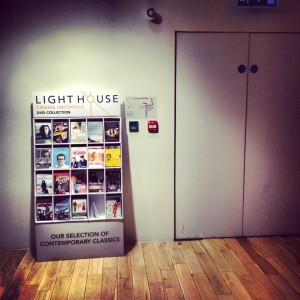The Lighthouse Cinema in Smithfield, Dublin entertains all of your senses. While it has four screens, 600 seats and a plethora of Irish, independent, foreign-language, arthouse and classical films the theater in and of itself provides an entertaining experience simply not seen in modern movie theaters.
The theater is tucked away in a commercial courtyard with only a mirrored sign and glimmering, clean, glass doors to identify it. As patrons walk into the cinema they are instantly greeted with the smell of fresh coffee and espresso wafting down the hall from the full-sized café located just beyond the ticketing booth. That is just what the front room is: a long hallway with a simple ticket desk run by a young, well-groomed man in a black shirt. Just past the ticket booth the hallway opens into a full café offering what a coffee house on the corner would. People are sitting at tables enjoying their espressos as if they had all the time in the world.
Unlike many other movie theaters The Lighthouse Cinema isn’t spread across a large stretch of land with all of the theaters on the same floor. Instead, moviegoers must descend several flights of stairs to get to their theater. The maze of stairs and hallways is surprising easy to navigate despite the sharp turns and many levels. Some of these extra stairs aren’t only stairs, but seating in themselves. Cushions are placed on half of the stairs so a screen can be lowered from the ceiling creating an impromptu theater in the center of the building.
The uniqueness of the cinema doesn’t end there; The lower levels of the complex are dimly-lit with backlit walls and mild, warm red and orange hues emitting from columns and select walls. The lighting gives the feeling that you’re already in your own film. Strategic lighting accentuates the sharp lines of the architecture and attempts to teleport you into the world of a film. Accompanying these beautiful colors is a plethora of seating outside of theaters for moviegoers. Beanbags, couches, coffee tables and chairs are placed in every corner of the complex. This may seem a bit strange until you encounter a small bar on the first level. The bar almost blends into the background of oranges and reds with its lighting and black countertops. While the drink selection may be overpriced and a bit limited, it fits perfectly in with the rest of the cinema.
The actual theaters are just as clean cut, warm and welcoming as the rest of The Lighthouse Cinema. Unlike other theaters, the floors are clean and not sticky with candy and soda. Not only are the seats comfortable, they are placed sensibly in the theater. Instead of cramming as many seats as possible in the theater, the floor in front of the screen is empty, allowing the film to be projected onto a large screen that is refreshingly comfortable to watch. The entire theater is a refreshing take on “going to the movies.”







